|
Issue
#3 | SB - 13
| 09 - 15 September |
Lyon, France.
|
Thursday
14 September 2000
|
|
Wednesday 12 September 2000 |
|
|
|
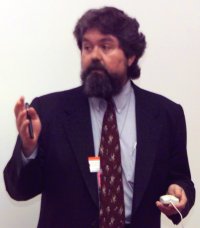 Title:
The World Bank climate change programmes Title:
The World Bank climate change programmes
Sponsor: The World Bank
Contact: Patrick Karani <pkarani@worldbank.org>
Internet: http://www-esd.worldbank.org/cc/
Johannes
Heister, The World Bank, introduced the Bank's climate change
programmes. He outlined the National Strategic Studies (NSS) on
Activities Implemented Jointly (AIJ) / Joint Implementation (JI)
/ and the Clean Development Mechanism (CDM) through which the Bank
helps countries to assess their options and strategies. He described
the Burkina Faso AIJ Project on Sustainable Energy Management which
aims to meet the growing urban wood fuel demand for domestic use
while maintaining forest biodiversity and ecosystems, without reducing
their carbon sequestration capacity. He concluded with a briefing
on the 2000 CDM Assist Programme for Building Capacity in Africa
which aims to enable African countries to benefit from the CDM by,
for example, enhancing their capacity to negotiate, generate and
transfer CERs.
Thomas
Black-Arbelaez, Ministry of the Environment, Colombia, (photo
above right) presented a Review of the NSS studies on the CDM. The
review analyzes the potential effects of proposed supplementarity
limits, on Zimbabwe and Colombia and the effects of proposed transaction
costs on the viability of the CDM. He concluded that under increasingly
strict supplementarity restrictions, the CDM is reduced to a low-profit,
low-benefit option. On the effects of potential transaction costs,
he concluded that they may minimize net resource inflows to developing
countries and reduce or eliminate the "financial additionality"
of many projects.
Ambassador
Erik Bjørnebye, Norway, briefed participants on the Norway-World
Bank AIJ Programme, designed to maximize the participation in, and
lessons learned from, the AIJ pilot phase of the FCCC. The Bank
is currently implementing three AIJ pilot projects: the Mexico High
Efficiency Lighting Pilot Project, the Poland Coal-to-Gas Conversion
Project and the Burkina Faso Sustainable Energy Project. An additional
project, recently approved, is the Integrated Agricultural Demand-side
Management Project with the Andhra Pradesh Electricity Board in
India.
|
|
 Title:
Fossil of the Day presentation Title:
Fossil of the Day presentation
Sponsors: Climate Action Network, Friends of the Earth, Greenpeace,
National Environmental Trust, WWF
Internet: http://www.fossil-of-the-day.org
Canada,
the US and Chile featured in the Fossil of the Day awards organized
by NGOs to highlight contentious negotiation positions. The daily
award ceremony is staged with the assistance of the popular Lyon-based
puppeteers, Guignol. The puppet shows summarize and parody the on-going
negotiations at SB-13.
Related
links:
Climate Action Network: http://www.climatenetwork.org
Friends of the Earth: http://www.foei.org
Greenpeace: http://www.greenpeace.org
WWF: http://www.panda.org
|
|
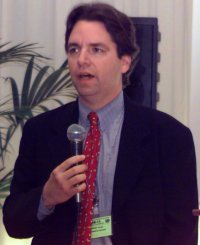 Title:
From obstacle to opportunity: lessons from the acid rain emissions
trading programme for the Kyoto Protocol Title:
From obstacle to opportunity: lessons from the acid rain emissions
trading programme for the Kyoto Protocol
Sponsor: Environmental Defense (ED)
Contact: Annie Petsonk <annie@edf.org>
Internet:
http://www.environmentaldefense.org
Outlining
the United States' experience with the acid rain (A/R) reduction
initiative, Joe Goffman, ED, (photo right) suggested that
it holds important lessons for international negotiators working
on the rules for the Kyoto Protocol. He explained that polluters
have been "over complying" with the US Clean Air Act because a market
for excess emissions reduction had been created by legislation.
In addition, the programme has induced technological innovation
that otherwise would not have happened, while keeping transaction
costs low.
Turning
to lessons for the Protocol process, Goffman argued that 'banking'
of allowable emissions should be permitted, to foster early reductions
during the first compliance period, and that a 'no exit' policy
has promoted cost effectiveness. He added that in the international
context of the KP, 'buyer liability' would ensure compliance. While
the A/R programme is national, market mechanisms such as emissions
trading have been applied regionally in the US to address the NOx
issue, concluded Goffman.
Ben
Feldman, Environmental Resources Trust (ERT), outlined the work
of the GHG Registry, which is modeled on the US EPA's Allowance
Tracking System (ATS). The Registry catalyzes markets to bring about
environmental benefits in the absence of an established regulatory
system by building the infrastructure for a GHG emissions trading
programme.
Discussion:
Participants raised questions about exporting the A/R programme,
the importance of the Second Budget Period of the Kyoto Protocol,
and on the modalities of the A/R programme.
Related Link:
Environmental Resources Trust: http://www.ert.net
|
|
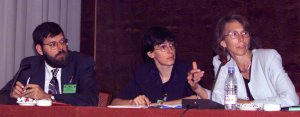 Title:
Setting standardized baselines for project-based activities: Case
studies in cement and steel, electricity generation and energy efficiency Title:
Setting standardized baselines for project-based activities: Case
studies in cement and steel, electricity generation and energy efficiency
Sponsor: Organisation for Economic Co-operation and Development
(OECD)
Contact: Jan-Corfee Morlot <jan.corfee-morlot@oecd.org>
Internet: http://www.oecd.org/env/cc/
http://www.iea.org
At
the request of the FCCC Annex I Expert Group, the Organisation for
Economic Co-operation and Development (OECD), together with the
International Energy Agency (IEA), provided overview papers on potentials
for standardizing emissions baselines methodologies for JI and CDM
projects. Jan Corfee-Morlot, OECD, provided a brief overview
of the different studies, including the cement, electricity, iron
and steel sectors and noted that a forestry sector study is underway.
Presenting results from "An Initial View on Methodologies for Emissions
Baselines: Cement Case Study", Jane Ellis, OECD, illustrated
the complexities of baselines for the industry sector, such as,
defining boundaries, establishing baseline units, data issues, additionality
and baseline lifetimes. Concluding, she highlighted that standardization
is possible at different levels of aggregation and stressed that
additionality requires baseline "tests" as well as qualitative additionality
checks. On "An Initial View on Methodologies for Emissions Baselines:
Case Study on Energy Efficiency", Jonathan Pershing, IEA,
illustrated multi-project baselines (M-P) using recent capacity
additions, comparing t  /GWh
values for wind and natural gas or wind and oil. Insights into the
electricity sector, indicated, for example, that M-Ps based on recent
capacity are a better reflection of the business-as-usual (BaU)
scenario. Jane Ellis, OECD, elaborated on a possible framework for
baseline standardization. She queried whether simple, generic guidance
on baseline methodologies could be defined and suggested the minimum
guidance required. She outlined elements for guidance, including:
project aggregation; project boundaries; project crediting lifetimes;
methods and assumptions; and data sources. Summarizing, she offered
options for generic guidance to address definitions and elements,
and to elaborate further methodological development with sufficient
flexibility to allow a-learning-by-doing approach. /GWh
values for wind and natural gas or wind and oil. Insights into the
electricity sector, indicated, for example, that M-Ps based on recent
capacity are a better reflection of the business-as-usual (BaU)
scenario. Jane Ellis, OECD, elaborated on a possible framework for
baseline standardization. She queried whether simple, generic guidance
on baseline methodologies could be defined and suggested the minimum
guidance required. She outlined elements for guidance, including:
project aggregation; project boundaries; project crediting lifetimes;
methods and assumptions; and data sources. Summarizing, she offered
options for generic guidance to address definitions and elements,
and to elaborate further methodological development with sufficient
flexibility to allow a-learning-by-doing approach.
Discussion:
Discussion themes included uncertainties regarding future predictions
of energy supply and demand, and how to maintain confidence about
the standardization of different parameters, methods, and baseline
values. The panel highlighted that a generic standardization sets
out values for transparency, whereas baselines at project-specific
level could lead to administrative burdens.
More
information:
For copies of the OECD/IEA reports see http://www.oecd.org/env/cc/
|
|
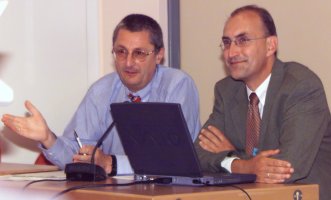 Title:
Capacity building for industry in six African countries Title:
Capacity building for industry in six African countries
Sponsor: United Nations Industrial Development Organization
(UNIDO)
Contact: Peter Pembleton <ppembleton@unido.org>
Internet: http://www.unido.org
Peter
Pembleton, UNIDO, (photo right, seated left) introduced background
studies prepared for Phase I of a programme designed to build capacity
in developing countries for participation in the CDM. Presenters
from Ghana, Kenya, Nigeria, Senegal, Zambia and Zimbabwe described
initial research to establish capacity building needs, to identify
barriers and review potential industrial projects for the CDM. Additional
phases will focus on programme development and implementation of
pilot projects.
Presenters
of the case studies identified a range of potential CDM candidate
industry sectors, including: power plants, iron and steel scrap
and aluminum smelting, cement and brick manufacturing, pulp and
paper production, vegetable oil production including energy recovery
from ground nut shells, copper production, and the sugar industry.
A number of presenters described how sustainable industrial development
could complement their national development plans, and each outlined
the potential for reduced and/or avoided  emissions should the proposed projects proceed.
emissions should the proposed projects proceed.
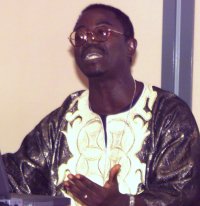 Discussion:
Participants raised questions about: the compatibility of a project
to substitute hydro-power with new thermal power capacity with the
CDM's objectives; the need to develop detailed calculations of the
costs attached to potential Discussion:
Participants raised questions about: the compatibility of a project
to substitute hydro-power with new thermal power capacity with the
CDM's objectives; the need to develop detailed calculations of the
costs attached to potential  reductions with a view to estimating the competitiveness of projects
within the context of the CDM; the probable focus on large scale
investments under the CDM and desirability of bundling African projects;
the need to consider the wider benefits of the UNIDO projects; the
absence of Least Developed Countries from the line up of participants
in UNIDO's Africa and CDM programme; and the low potential for emissions
reduction projects in Africa.
reductions with a view to estimating the competitiveness of projects
within the context of the CDM; the probable focus on large scale
investments under the CDM and desirability of bundling African projects;
the need to consider the wider benefits of the UNIDO projects; the
absence of Least Developed Countries from the line up of participants
in UNIDO's Africa and CDM programme; and the low potential for emissions
reduction projects in Africa.
More
information:
UNIDO project website: http://www.unido.org
|
|
 Title:
Results of the international emissions trading simulation of
the IEA Title:
Results of the international emissions trading simulation of
the IEA
Sponsor: International Energy Agency (IEA)
Contact: Richard Baron <richard.baron@iea.org>
Internet: http://www.iea.org
Richard Baron, IEA, (photo right) presented the results of
an international emissions trading simulation designed to deliver
hands-on experience in an international  emissions trading scheme. Approximately 24 countries participated
in this effort, representing both Annex I countries and EITs. Participants
had to make decisions on whether to buy allowances in the international
market or achieve domestic emissions reductions, given their countries'
emissions trajectories and compliance options. The simulation showed
that the overall cost saving potential of a trading scheme was approximately
60%, but that results varied dramatically across countries. In addition,
some EITs reduced their emissions beyond compliance levels to sell
excess allowances on the international market. The outcome indicates
the need for government monitoring of assigned amounts and inventories,
and the importance of market transparency. Several participants
in the trading simulation spoke of their experiences, stressing
that it had been a useful learning experience. The participant who
adopted the role of the EU explained that he aimed to reflect the
EU's position on domestic action, and thus avoided trading. Other
participants aimed to find the least-cost options for compliance.
The participant who adopted the role of the US remarked that no
information on other countries' abatement costs was available to
the market.
emissions trading scheme. Approximately 24 countries participated
in this effort, representing both Annex I countries and EITs. Participants
had to make decisions on whether to buy allowances in the international
market or achieve domestic emissions reductions, given their countries'
emissions trajectories and compliance options. The simulation showed
that the overall cost saving potential of a trading scheme was approximately
60%, but that results varied dramatically across countries. In addition,
some EITs reduced their emissions beyond compliance levels to sell
excess allowances on the international market. The outcome indicates
the need for government monitoring of assigned amounts and inventories,
and the importance of market transparency. Several participants
in the trading simulation spoke of their experiences, stressing
that it had been a useful learning experience. The participant who
adopted the role of the EU explained that he aimed to reflect the
EU's position on domestic action, and thus avoided trading. Other
participants aimed to find the least-cost options for compliance.
The participant who adopted the role of the US remarked that no
information on other countries' abatement costs was available to
the market.
Discussion:
Participants posed questions about the marginal abatement curve,
on which sectors and gases were covered, and the importance of the
second Budget Period for decision-making.
|
|
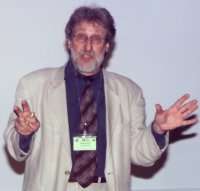 Title:
Positive list for the CDM Title:
Positive list for the CDM
Sponsor: World Wildlife Fund (WWF) and Climate Network Europe
(CNE)
Contact: Liam Salter <lsalter@wwf.int.org>
Internet: http://www.panda.org
Chair
Dave Hawkins, Natural Resources Defence Council, introduced
the panel discussion on a positive list for the CDM. Dr Stephen
Bernow, Tellus Institute, presented the findings of the report,
"Cleaner Generation, Free-Riders and Environmental Integrity:
CDM and the Power Sector". The report consists of an analysis
undertaken for the World Wildlife Fund by the Tellus Institute in
collaboration with the Stockholm Environment Institute. The analysis
provides an estimate of the potential carbon emission impacts of
the CDM, focusing on new power plants in the power sectors of non
Annex I countries. In conclusion, Bernow noted that while the CDM
could induce some legitimate reduction in emissions from electricity
generation in host countries, it could also give rise to a prominent
amount of "spurious" emissions allowances by crediting "free-rider"
activities. Dr Sujata Gupta, TERI, India, made a presentation on
Initiating CDM Environmental and Developmental Concerns. She stated
that before a positive CDM list is agreed, there is a strong need
to address additionality, baselines and sustainable development,
in the process of establishing guidelines. Douglas Korsah-Brown,
FoEI, highlighted the importance of considering sustainable development
to maintain the integrity of the KP. Liam Salter, WWF International,
stressed that under the CDM, 94% of the business-as-usual scenario
for the power sector remains unchanged. He suggested keeping "free
riders" out by restricting the eligibility of technologies and maintaining
a focus, in principle, on inherently low risk technologies.
Discussion:
Discussion revolved around the European Union, US and Peruvian positions
on a positive list for the CDM and the eligibility thresholds for
power plants. On a positive list, participants discussed how to
achieve principles that address equity with regard to technology
transfer. Issues were raised concerning developing country participation
and how they could benefit, particularly with regard to the CDM
and renewable energy projects that could risk excluding certain
geographical regions. On "free riding" the Environmental Integrity
Group pointed out that the CDM is another example of the need for
good management and strict adherence to principles.
Related links:
http://www.teriin.org
http://www.tellus.org
|
| The
Earth Negotiations Bulletin (ENB) on the side is
a special publication of the International Institute for Sustainable
Development (IISD) in cooperation with the United Nations Framework
Convention on Climate Change (UNFCCC) Secretariat. The Editor of ENB
on the side is Peter Doran Ph.D <peter@iisd.org>. This issue
has been written by Emily Boyd <E.Boyd@uea.ac.uk>, Hernan Lopez
LL.M. <hlopez@law.pace.edu> and Gerhard Mulder <gerhardmulder@hotmail.com
>. The Digital Editor is Kenneth Tong <ken@iisd.org>. Photos
by Leila Mead <leila@interport.net>. Funding for publication
of ENB on the side at SB-13 is provided by the UNFCCC Secretariat.
The opinions expressed in ENB on the side are those of the
authors and do not necessarily reflect the views of IISD and other
funders. Excerpts from ENB on the side may be used in non-commercial
publications only and only with appropriate academic citation. For
permission to use this material in commercial publications, contact
the Managing Editor at <kimo@iisd.org>. Electronic versions
of these issues of ENB on the side from SB-12 can be found
on the Linkages WWW server at http://enb.iisd.org/climate/sb13/ |
|


